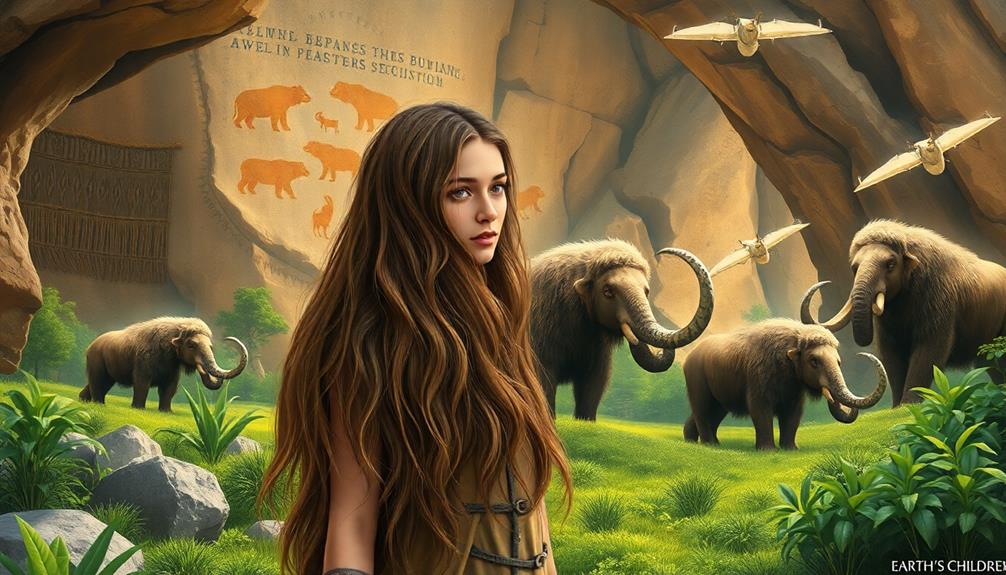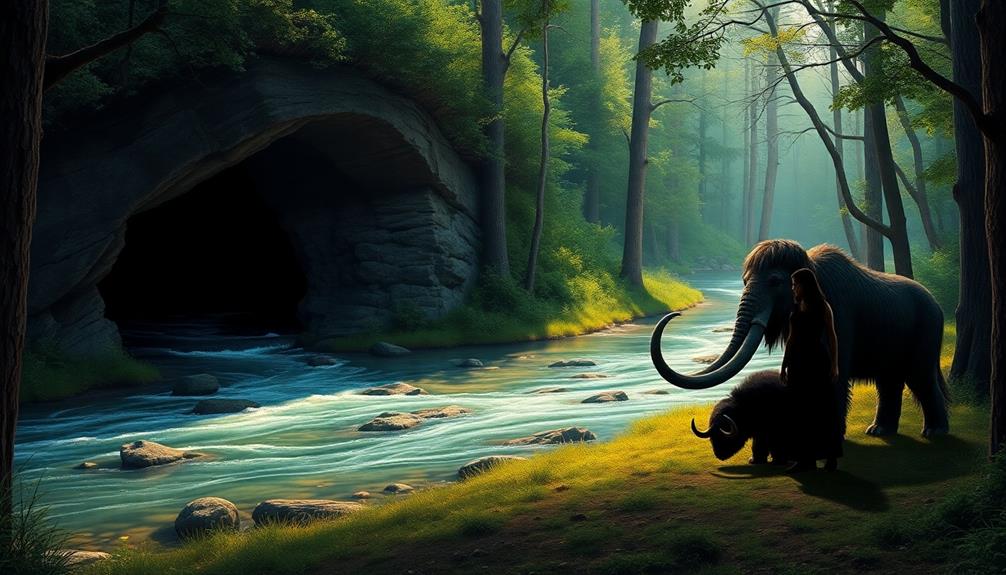You're about to meet Jean M. Auel, the remarkable author of 'The Clan of the Cave Bear.' Born in 1936 in Chicago, she drew upon her Finnish heritage and extensive research on prehistoric life to create her iconic series, Earth's Children. Her first novel, published in 1980, has sold over 45 million copies worldwide, highlighting themes of survival, community, and the complexities of gender roles in early human societies. Auel's immersive storytelling and vivid characters, especially Ayla, resonate deeply with readers. Stick around to uncover more about her fascinating journey and the impact of her work.
Author Background
Born as Jean Marie Untinen in Chicago on February 18, 1936, Jean M. Auel grew up with a rich Finnish heritage. After high school, she married Ray Auel and moved to Oregon, where she raised five children.
While balancing family life, you might be surprised to learn she pursued higher education, eventually earning an MBA from Portland State University in 1976. Auel's fascination with the prehistoric world sparked her writing journey, similar to how the triumph of the human spirit is showcased in narratives like Louis Zamperini's survival story in "Unbroken."
In 1977, she began crafting stories focused on the interactions between Cro-Magnon people and Neanderthals. Her commitment to authenticity led her to conduct extensive research on Ice Age Europe, including visits to various prehistoric sites. This dedication laid the foundation for her groundbreaking work, the Earth's Children series.
Through her meticulous research and vivid storytelling, Auel brought the prehistoric world to life, giving readers a profound understanding of early human existence.
Her unique background and academic achievements have greatly shaped her perspective as an author, ensuring that her narratives resonate with both historical accuracy and emotional depth.
Literary Career
You'll find that Jean M. Auel's literary journey took off in 1977, sparked by her fascination with prehistoric societies.
Her groundbreaking first novel, "The Clan of the Cave Bear," not only became a bestseller but also set the stage for her successful six-part series, "Earth's Children."
Auel's work is often compared to the depth and richness found in classic sci-fi literature, showcasing her ability to create immersive worlds.
With over 45 million copies sold globally, Auel's meticulous research and storytelling have left a lasting mark on historical fiction, much like the impact of classic sci-fi books.
Early Writing Journey
In 1977, Jean M. Auel initiated her writing journey with a short story that explored the interactions between Cro-Magnon and Neanderthal people. This initial foray into writing marked the beginning of her fascination with prehistoric life.
By 1980, she published her first book, *The Clan of the Cave Bear*, which quickly enthralled the attention of readers and critics alike. Its success paved the way for a film adaptation in 1986, further cementing Jean's place in literary history.
Auel's dedication to her craft was impressive, as she balanced motherhood, a full-time job, and education while writing. Often, she'd find herself working late into the night, driven by a passion for storytelling.
Her commitment to authenticity led her to conduct extensive research on Ice Age Europe, traveling to various prehistoric sites across the continent to inform her narratives.
The *Earth's Children* series, beginning with *The Clan of the Cave Bear*, eventually grew to six books, selling over 45 million copies worldwide.
Jean's unique blend of historical accuracy and engaging storytelling greatly impacted the historical fiction genre, inspiring countless readers and writers.
Research and Inspiration
Jean M. Auel's literary journey began in 1977, fueled by her passion for research and a fascination with the prehistoric world. To craft her stories authentically, she immersed herself in the Ice Age, exploring various aspects of early human life.
Here are some key elements of her research and inspiration:
- Survival Class: Auel joined a survival class, learning primitive skills that greatly influenced her storytelling.
- Extensive Travel: She traveled to significant prehistoric sites across Europe, including the Lascaux cave, to gather insights.
- Anthropological Insights: Auel's work blends fiction with anthropological research, enriching her narratives with accurate cultural details.
- Meticulous Research: Her Earth's Children series showcases her dedication to thorough research, making her stories resonate with authenticity.
Auel's debut novel, "The Clan of the Cave Bear," published in 1980, rapidly became a sensation and was even adapted into a film in 1986.
Series Success Metrics
The staggering success of Jean M. Auel's *Earth's Children* series is nothing short of remarkable. Since its debut in 1980, the series has sold over 45 million copies worldwide. You can appreciate how the first book, *The Clan of the Cave Bear*, set the stage for this achievement, enchanting readers from the get-go.
By 1990, the first three books had sold over 20 million copies, demonstrating the series' strong initial impact. The 1986 film adaptation of *The Clan of the Cave Bear* also played a vital role in amplifying the series' popularity, attracting new audiences and bolstering book sales.
By May 2002, total sales surged to approximately 34 million copies, showcasing an enduring interest in Auel's vivid storytelling. Moreover, the series has been translated into 18 languages, emphasizing its global appeal and influence within the historical fiction genre.
It's clear that Auel hasn't just created a series; she's built a literary phenomenon that continues to resonate with readers, including children, around the world. The legacy of *Earth's Children* is a reflection of Auel's impact on literature.
Earth's Children Series

With six enthralling novels, the Earth's Children series immerses you in the life of Ayla, a Cro-Magnon orphan traversing a prehistoric world over 30,000 years ago.
Starting with *The Clan of the Cave Bear* and concluding with *The Land of Painted Caves*, this series showcases Ayla's journey of survival and her quest for identity among modern humans and Neanderthals.
Auel's storytelling, much like the intricate plotting in historical mysteries such as The Daughters of Night, draws readers into the depths of human experience and societal challenges.
Here are four key aspects of the Earth's Children series:
- Cultural Interactions: Auel's meticulous research highlights the interactions between Cro-Magnon and Neanderthal societies, enriching the narrative with anthropological insights.
- Themes of Love: Central to the series are themes of love, family, and community, exploring Ayla's relationships and her struggles to fit into different cultural environments.
- Survival Challenges: The novels vividly depict Ayla's challenges in a harsh, prehistoric world, showcasing her resilience and ingenuity.
- Popularity: By 1990, the first three books had sold over 20 million copies, solidifying Auel's impact on prehistoric fiction.
The Earth's Children series invites you into a fascinating world where history and humanity intertwine.
Themes and Exploration
In *The Clan of the Cave Bear*, you'll see how survival and adaptation shape the lives of early humans.
Auel challenges traditional gender roles through Ayla's journey, showcasing her growth and resilience in a male-dominated society. Her ability to navigate the complexities of her environment mirrors the overcoming adversity with courage found in many inspiring memoirs.
As you explore themes of community and belonging, you'll understand the crucial connections that help her navigate a harsh world.
Survival and Adaptation
Exploring survival and adaptation in *The Clan of the Cave Bear*, Jean M. Auel immerses you in the struggles of Ayla as she navigates prehistoric Europe. Through her journey, you witness the stark cultural differences between Neanderthals and Cro-Magnons, highlighting how adaptation is essential for survival.
Ayla's experiences reveal her growth, both physically and emotionally, as she learns important skills and forges connections.
Here are four key aspects of survival and adaptation in the novel:
- Essential Skills: Ayla masters hunting, foraging, and crafting tools, showcasing her ability to adapt to her environment.
- Cultural Integration: She learns to navigate the complex social dynamics of various clans, emphasizing the significance of understanding cultural differences.
- Identity and Belonging: Ayla's constant adaptation underscores her struggle for identity while working to fit into different communities.
- Collaboration and Innovation: Auel illustrates how prehistoric humans thrived through cooperation and creative problem-solving.
Together, these elements create a powerful narrative about the resilience and adaptability of individuals in the face of harsh realities, making Auel's work truly compelling.
Gender Roles Exploration
Ayla's journey in *The Clan of the Cave Bear* not only highlights her survival skills but also challenges the traditional gender roles of her time. As a boundary-pushing figure, she embodies individual capabilities that defy the expectations placed on women in her prehistoric society. Auel crafts a narrative that emphasizes the significance of community care, showing how both men and women contribute to the survival and cohesion of their clans.
Throughout the story, Ayla navigates and often subverts patriarchal structures that seek to limit her potential. Her emotional and physical growth reflects her struggle for identity in a world that marginalizes her due to her gender and origins.
Auel intricately explores the complexities of gender dynamics, illustrating that strengths and roles aren't inherently tied to gender but shaped by the context and individual capabilities.
In doing so, Auel presents a nuanced perspective on gender roles, inviting readers to reconsider what defines competence and value within a community. Ayla's story isn't just about survival; it's a powerful commentary on the flexibility of gender roles and the importance of recognizing diverse abilities in all individuals.
Community and Belonging
Community and belonging are fundamental themes in *The Clan of the Cave Bear*, shaping the narrative and Ayla's journey. As you follow Ayla's story, you witness her struggle to find her identity amidst the diverse clans and their cultural differences. This exploration of community highlights several key aspects:
- Survival: In prehistoric Europe, community is essential for survival, offering support and protection.
- Cultural Exchanges: Ayla's interactions with different clans reveal how cultural exchanges shape identity and belonging.
- Personal Growth: Her experiences within various groups foster personal growth, illustrating the significance of love, family, and social dynamics.
- Emotional Depth: The narrative challenges stereotypes, showing that compassion and cooperation are crucial to human connection.
Through Ayla's journey, Auel emphasizes the adaptability of individuals within their communities. You see how relationships and shared experiences contribute to a sense of belonging, enriching the human experience.
Ultimately, the themes of community and belonging resonate deeply, demonstrating that even in harsh environments, the bonds forged among people can lead to profound personal and collective growth.
Reader Reactions

Many readers form deep emotional bonds with Ayla in *The Clan of the Cave Bear*, often sharing their own stories that mirror her struggles and triumphs.
These reader reactions highlight how Ayla's journey resonates with themes of survival, identity, and belonging, prompting fans to engage in passionate discussions online. Many of you may find yourselves revisiting the *Earth's Children* series multiple times, drawn back by the depth of Auel's storytelling and the relatable struggles of a modern human like Ayla.
This connection to Ayla's resilience is reminiscent of the courage shown by women facing adversities in Unbreakable Non-Fiction Tales of Survival and Hope.
However, not all feedback has been positive. Some readers express disappointment with the pacing and plot development in *The Land of Painted Caves*, leading to mixed reviews within the fan community.
Despite this, the anticipation for potential film or series adaptations demonstrates Auel's enduring influence. You can feel the excitement as fans speculate on how Ayla's world will come to life on screen.
Ultimately, the emotional connections you've forged with Ayla and the discussions sparked by her journey reflect the profound impact of Auel's work, making it a cherished part of many readers' lives.
Impact and Legacy
Jean M. Auel's *Earth's Children* series, starting with *The Clan of the Cave Bear*, has left a profound impact on both literature and cultural history. With over 45 million copies sold worldwide, Auel's work has shaped the historical fiction genre and sparked an interest in prehistoric life and anthropology.
Her novels reflect the complexity of global cultures, encouraging readers to explore the interconnectedness of human experiences through storytelling, much like the themes presented in literary exploration of global cultures.
Here are some key aspects of her legacy:
- Global Reach: The series has been translated into 18 languages, ensuring its influence spans diverse cultures.
- Cultural Impact: Auel's meticulous research has captivated readers and fueled discussions about early human civilization.
- Film Adaptation: The 1986 film adaptation of *The Clan of the Cave Bear* further cemented her presence in popular culture.
- Inspiring Research: Auel's storytelling has inspired a dedicated fan base and encouraged ongoing research into humanity's past.
Through her vivid depictions of prehistoric life, Auel has made a lasting legacy that goes beyond mere entertainment.
She's opened the door for readers and scholars alike to explore anthropology and our shared cultural history, making her work both impactful and significant.
Conclusion
In exploring Jean M. Auel's work, you've journeyed through a rich tapestry of prehistoric life, where every page pulses with vivid imagery and deep emotion. Her ability to weave complex themes of survival and connection makes you reflect on your own place in the world. Just like Ayla, you too navigate your own challenges, carving out your identity. Auel's legacy isn't just in her books; it's in the way you see humanity's shared story.



